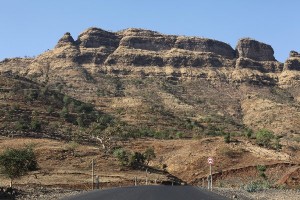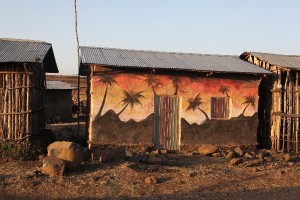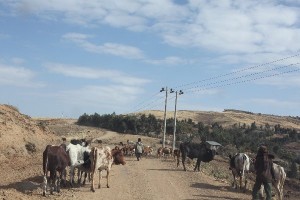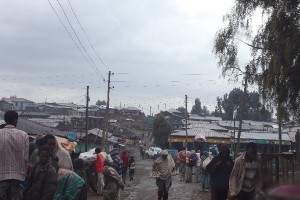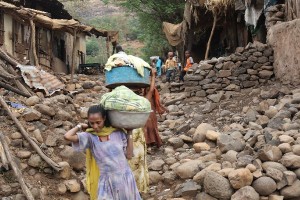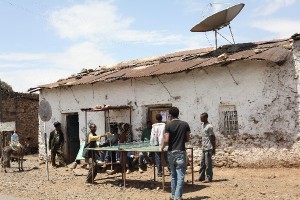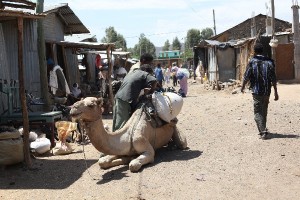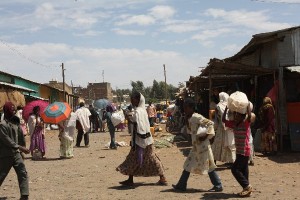Ethiopia is a country on the move – cattle, goats, horses, donkeys, camel, people. At any given time, it feels like 98% of the population of any village or town is on the road the moment you happen to be driving through. And should you stop for a bush wee, you have 5 seconds at most before the remaining 2% will appear through the bushes. So no chance of wild camping in this country I suspect!
The change in landscape and population couldn’t be greater as we crossed the border from Sudan to Ethiopia. From flat, dry, dusty Sudan, we were now driving along steep winding roads, surrounded by fertile land. Ethiopians walk long distances and they walk fast, even uphill along mountain roads – you can understand why the country produces such excellent long distance runners. Ethiopia is also very densely populated, and most of the villages are built right on the roadside. There was clearly far less traffic on the roads when these houses were built, and as a result life is lived in the middle of the road with very little awareness of the dangers of cars. Even if you’re driving slowly, you still have to hoot to get people out of the way. In almost comic fashion, they leap into the air startled, and will take the least sensible and longest route to one side of the road or the other, usually crossing in front of the advancing car first! The situation can only become worse as car ownership increases and people drive faster on the ever expanding network of Chinese built tar roads.
A description of the differences we experienced in crossing from Sudan to Ethiopia wouldn’t be complete without speaking of how any foreigner is welcomed when driving through the villages. In Sudan, the most anyone asked us for was to charge their mobile phone in the car whilst we visited the pyramids or temples as the guardians have no electricity at their huts. In fact, most people were keen to offer you tea or food or to just have a chat. In Ethiopia, everywhere along the road, and in villages and towns, you are only a few seconds away from the next cry of “you you you you you”, “money money money”, “give me 1 birr”, “give me 50 birr”, “give me pen”, “give me jacket”, “give me hat”, “give me…”, well, anything else you happen to be wearing or is visible in your car that takes their fancy. Coming from Sudan, especially, this was quite a shock. It feels like there is an expectation that every foreigner will hand out something. It is relentless, and every tourist we meet talks of it. The demands come mainly from kids aged 2 to 12, so those born after the most active period of ‘handouts’ during the 80s famine. There is still, however, a huge and evident aid agency presence all over the country, and debate rages amongst both visitors and locals over how useful their continued long term presence is in assisting the country to become self sufficient. With such a high level of expectation of foreigners – tourists and NGOs alike – from the younger generation, it will be interesting how the country develops in the next few years.
Talking to other tourists we meet, how much they enjoy Ethiopia is often linked to how able they are to look beyond the ‘handout culture’ amongst the kids and how much interaction they have with other Ethiopians who are genuinely welcoming. I particularly enjoyed meeting people for the second or third time, when they would greet us in the traditional way friends greet each other by shaking our hands and simultaneously pressing right shoulder to right shoulder. And the country itself is incredible – each region is so different and, like others we speak to, I’m sure we’ll be back to explore some more.
Ethiopia is a country on the move – cattle, goats, horses, donkeys, camel, people. At any given time, it feels like 98% of the population of any village or town is on the road the moment you happen to be driving through. And should you stop for a bush wee, you have 5 seconds at most before the remaining 2% will appear through the bushes. So no chance of wild camping in this country I suspect!
The change in landscape and population couldn’t be greater as we crossed the border from Sudan to Ethiopia. From flat, dry, dusty Sudan, we were now driving along steep winding roads, surrounded by fertile land. Ethiopians walk long distances and they walk fast, even uphill along mountain roads – you can understand why the country produces such excellent long distance runners. Ethiopia is also very densely populated, and most of the villages are built right on the roadside. There was clearly far less traffic on the roads when these houses were built, and as a result life is lived in the middle of the road with very little awareness of the dangers of cars. Even if you’re driving slowly, you still have to hoot to get people out of the way. In almost comic fashion, they leap into the air startled, and will take the least sensible and longest route to one side of the road or the other, usually crossing in front of the advancing car first! The situation can only become worse as car ownership increases and people drive faster on the ever expanding network of Chinese built tar roads.
A description of the differences we experienced in crossing from Sudan to Ethiopia wouldn’t be complete without speaking of how any foreigner is welcomed when driving through the villages. In Sudan, the most anyone asked us for was to charge their mobile phone in the car whilst we visited the pyramids or temples as the guardians have no electricity at their huts. In fact, most people were keen to offer you tea or food or to just have a chat. In Ethiopia, everywhere along the road, and in villages and towns, you are only a few seconds away from the next cry of “you you you you you”, “money money money”, “give me 1 birr”, “give me 50 birr”, “give me pen”, “give me jacket”, “give me hat”, “give me…”, well, anything else you happen to be wearing or is visible in your car that takes their fancy. Coming from Sudan, especially, this was quite a shock. It feels like there is an expectation that every foreigner will hand out something. It is relentless, and every tourist we meet talks of it. The demands come mainly from kids aged 2 to 12, so those born after the most active period of ‘handouts’ during the 80s famine. There is still, however, a huge and evident aid agency presence all over the country, and debate rages amongst both visitors and locals over how useful their continued long term presence is in assisting the country to become self sufficient. With such a high level of expectation of foreigners – tourists and NGOs alike – from the younger generation, it will be interesting how the country develops in the next few years.
Talking to other tourists we meet, how much they enjoy Ethiopia is often linked to how able they are to look beyond the ‘handout culture’ amongst the kids and how much interaction they have with other Ethiopians who are genuinely welcoming. I particularly enjoyed meeting people for the second or third time, when they would greet us in the traditional way friends greet each other by shaking our hands and simultaneously pressing right shoulder to right shoulder. And the country itself is incredible – each region is so different and, like others we speak to, I’m sure we’ll be back to explore some more.

